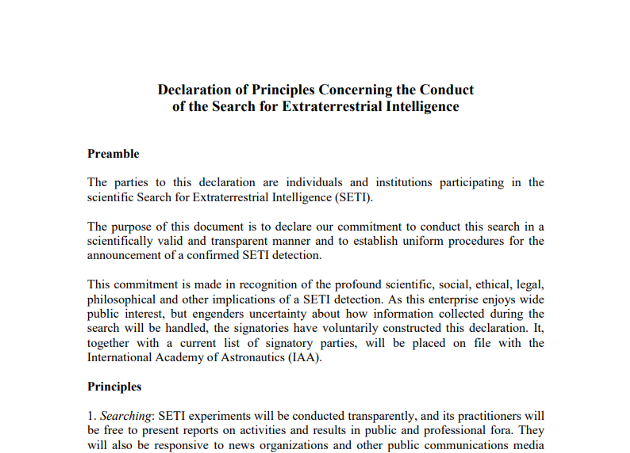# Preparing Humanity for Alien Contact: The New SETI Hub
Written on
Chapter 1: The Quest for Extraterrestrial Life
The question of whether intelligent life exists elsewhere in the Universe remains one of science's most profound enigmas. Researchers are actively working to find answers. The Search for Extraterrestrial Intelligence (SETI) is a prominent field within astronomy, utilizing radio telescopes to detect signals from advanced alien civilizations.
As scientists edge closer to potentially uncovering signs of alien life, a pressing question arises: what is the most effective way to share this groundbreaking discovery with the world? Additionally, should humanity reach out in response? Researchers are delving into these complex issues.
On November 2, 2022, the University of St. Andrews in the UK launched a new SETI Post-Detection Hub. This center aims to serve as an international platform that unites experts from diverse scientific and humanistic backgrounds. Its primary purpose is to develop impact assessments, protocols, and procedures for when signals of extraterrestrial life are detected.
Dr. John Elliott, who is coordinating the hub and is an honorary fellow in the School of Computer Science at the University, emphasized the need for a collaborative approach. "We must coordinate our expert knowledge not only for evaluating the evidence but also for considering the societal response as our understanding evolves," he stated in a press release.
Currently, there are no official government guidelines detailing the steps to take upon detecting signs of extraterrestrial civilizations. While the United Nations has established protocols for threats like asteroid impacts, there is a significant lack of guidance for discovering alien life.

Chapter 2: Establishing Protocols for Discovery
The International Academy of Astronautics (IAA) has created the only recognized post-detection protocol, initially drafted in 1989 and last updated in 2010. This framework offers general guidelines for how humanity should respond to the discovery of extraterrestrial civilizations. However, it mainly emphasizes scientific conduct and lacks enforceability.
The newly established SETI Post-Detection Hub addresses these critical policy gaps while promoting responsible communication in science. For the first time, it creates a permanent establishment aimed at coordinating a comprehensive framework for the discovery of extraterrestrial life. This includes topics such as message decryption, protocol development, and strategies for societal impact.
The hub seeks to unite the SETI community, broader academic circles, and policy experts to collaborate effectively. Participants bring expertise from various fields, including astronomy, computer science, zoology, anthropology, and science communication.
A vital objective of Dr. Elliott’s role is to facilitate transparent information sharing about extraterrestrial signal detection across nations. He also aims to tackle the challenges posed by today’s news landscape, which is heavily influenced by social media, often leading to misinformation and conspiracy theories.
The video titled "C'est quoi le plan si les aliens nous contactent?" explores potential plans for humanity's response if we were to make contact with aliens. It delves into the implications and necessary preparations that might be required.
Chapter 3: Preparing for the Unknown
The hub will also develop strategies to help society brace for the potential discovery of alien life. The nature of the aliens—whether microbial or technological—will significantly influence humanity's response, and various scenarios are under consideration.
Discovering extant technological civilizations may present some of the greatest challenges for humanity. Addressing the social ramifications of such a revelation will be crucial. Additionally, monitoring any ongoing signals from the civilization will be necessary. The hub will also need to discuss the risks associated with these species and whether humanity should respond, including what the content of that response might entail. The implications of such a discovery could pose an existential threat to humanity, necessitating cautious deliberation.
Conclusion: A New Era in SETI Research
Many who follow developments in this field know that I have extensively discussed the possibility of intelligent alien civilizations. Personally, I lean toward the belief that such beings likely exist.
Historically, funding for SETI research has been limited. However, the current landscape is markedly different, with significant financial backing from Silicon Valley billionaires. Additionally, advancements in technology—such as computational power, storage, and detection algorithms—have greatly enhanced modern SETI endeavors. Given this revitalization, it would not be surprising to find evidence of extraterrestrial civilizations in this century.
The IAA’s Post-Detection Protocol serves as a solid foundation, and establishing the new Post-Detection Hub represents a significant step forward. It requires minimal resources to set up and operate while equipping humanity for a potential existential revelation. I wholeheartedly support this initiative!
What are your thoughts? Please feel free to share your insights in the comments. I will do my best to respond to all serious inquiries!
If you enjoyed this article, you might find these pieces interesting:
- What Happens the Day After We Discover Aliens? — The Post-Detection Protocol.
- 3 Times in History When Scientists Thought We Made Contact With Aliens — An exploration of past events.
- The Fermi Paradox: Where Are All the Aliens? — Considering our solitude in the Universe.
References:
- Declaration of Principles Concerning the Conduct of the Search for Extraterrestrial Intelligence. http://resources.iaaseti.org/protocols_rev2010.pdf.